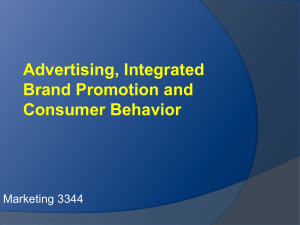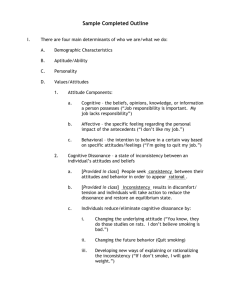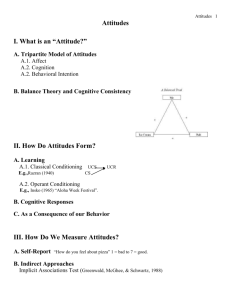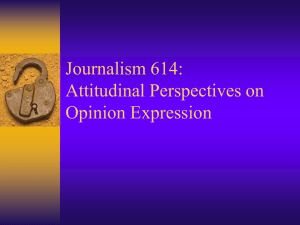Chapter 5 Advertising, Integrated Brand Promotion, & Consumer
advertisement
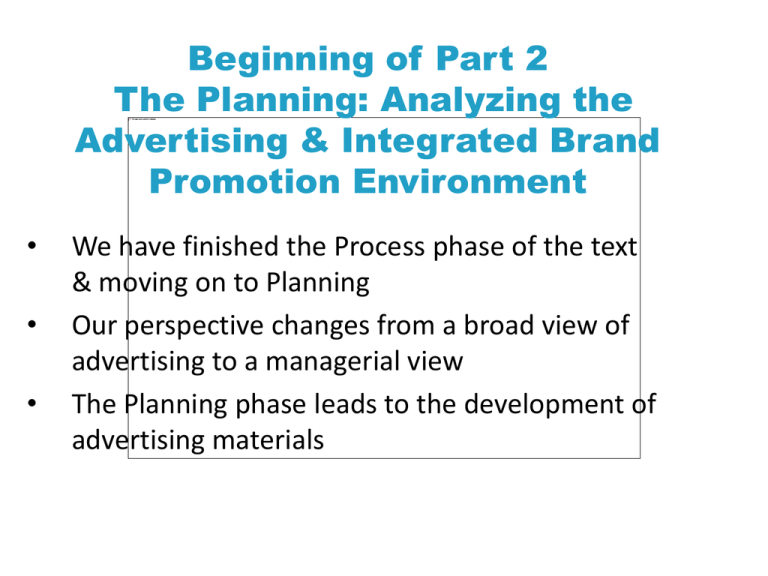
Beginning of Part 2 The Planning: Analyzing the Advertising & Integrated Brand Promotion Environment • • • We have finished the Process phase of the text & moving on to Planning Our perspective changes from a broad view of advertising to a managerial view The Planning phase leads to the development of advertising materials 5 Advertising & Consumer Behavior Consumer Behavior Consumer Behavior: a wide spectrum of things that affect, derive from, or form the context of human consumption. Perspectives: 1. Consumers are Systematic decision makers – Maximizing the benefits from purchases defines the purchase—consumers are deliberate 2. Consumers are Active Interpreters – – Cultural/social membership defines purchases Gender matters The consumer decision-making process 1. Need recognition --Functional or Emotional benefits 2. Information Search & Evaluation --Internal & External search --Consideration Set --Evaluative Criteria 3. Purchase 4. Post-purchase use & evaluation Customer satisfaction Cognitive dissonance Cognitive Dissonance The feelings of doubt & concern after a purchase is made. Dissonance increases when 1. 2. 3. 4. 5. The purchase price is high There are many close alternatives The item is intangible (example?) The purchase in important The item purchased lasts a long time Cognitive Dissonance • Cognitive dissonance refers to a situation involving conflicting attitudes, beliefs or behaviors. This produces a feeling of discomfort leading to an alteration in one of the attitudes, beliefs or behaviors to reduce the discomfort and restore balance. For example, when people gamble (behavior) and they know that the odds are against them (cognition). • Festinger's (1957) theory suggests that we have an inner drive to hold all our attitudes and beliefs in harmony & avoid disharmony (or dissonance). Cognitive Dissonance • Attitudes may change because of factors within the person. An important factor here is the principle of cognitive consistency; we seek consistency in our beliefs and attitudes in any situation where cognitions are inconsistent. • A powerful motive to maintain cognitive consistency can give rise to irrational and sometimes maladaptive behavior. We hold many cognitions about the world and ourselves; when they clash, a discrepancy is evoked, resulting in a state of tension known as cognitive dissonance. As the experience of dissonance is unpleasant, we are motivated to reduce or eliminate it, and achieve consonance (i.e. agreement). Modes of Consumer Decision-Making: (Vary by involvement & experience) 1. Extended Problem Solving • Deliberate, careful search 2. Limited Problem Solving • Common products, limited search 3. Habit or Variety Seeking • Variety seeking—switch brands at random • Habit—buy single brand repeatedly 4. Brand Loyalty • Conscious commitment to find same brand each time purchase is made Are you brand loyal to a softdrink? Key Psychological Processes in Advertising 1. Attitude -- Overall evaluation of an object person or issue on continuum=like/dislike; positive/negative 2. Brand Attitude – Summary evaluations that reflect preferences for various products & services 3. Salient Beliefs – Small number of key beliefs. Five to nine salient beliefs typically form the critical determinants of attitude Key Psychological Processes Multi-Attribute Models (MAAMs) • Evaluative Criteria: attributes consumers use to compare brands • Importance Weights: priority assigned to attributes • Consideration Set: group of brands that are focal point of decision effort • Beliefs: knowledge & feelings consumer has about various brands. We Want to Believe! Key Psychological Processes Information Processing & Perceptual Defense • Cognitive Consistency Impetus: Strongly held beliefs to make efficient decisions • Advertising Clutter: Large volume of ads causes overload • Cognitive responses: Thoughts that occur to consumer at moment when beliefs are challenged by persuasive communication Key Psychological Processes The Elaboration Likelihood Model (ELM) • Central route persuasion in high involvement products • Peripheral cues rather than strong arguments shape attitudes in low-involvement products Persuasion is Hard with Routine Behaviors. Advertising as Social Text: How Ads Transmit Sociocultural Meaning Culturally constituted world Advertising / fashion system Fashion system Consumer goods Possession ritual Exchange ritual Grooming ritual Individual consumer Divestment ritual Factors Impacting Consumer Decision Making VALUES / ATTITUDES REFERENCE GROUPS SITUATIONAL FACTORS CULTURE NEEDS EDUCATION CONSUMER DECISIONS PLEASURE PERSONALITY GENDER FAMILY NEWS MAGAZINES RADIO TELEVISION DIRECT MEDIA MEDIA MARKETERCONTROLLED STIMULI SOCIAL CLASS PAST EXPERIENCE LIFE-STYLE SUBCULTURES PRICE PACKAGING ADVERTISING PROMOTION PERSONAL SELLING
